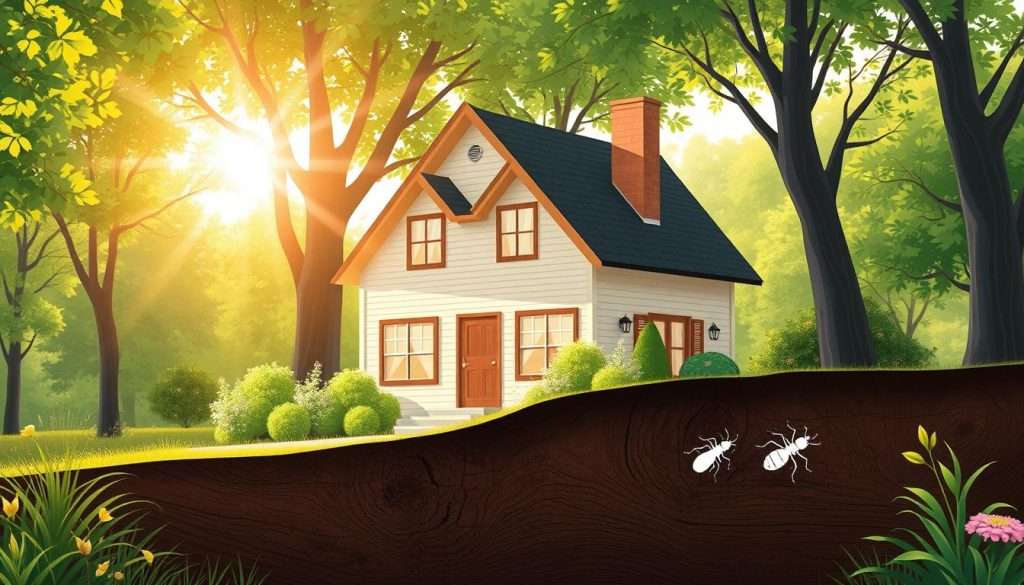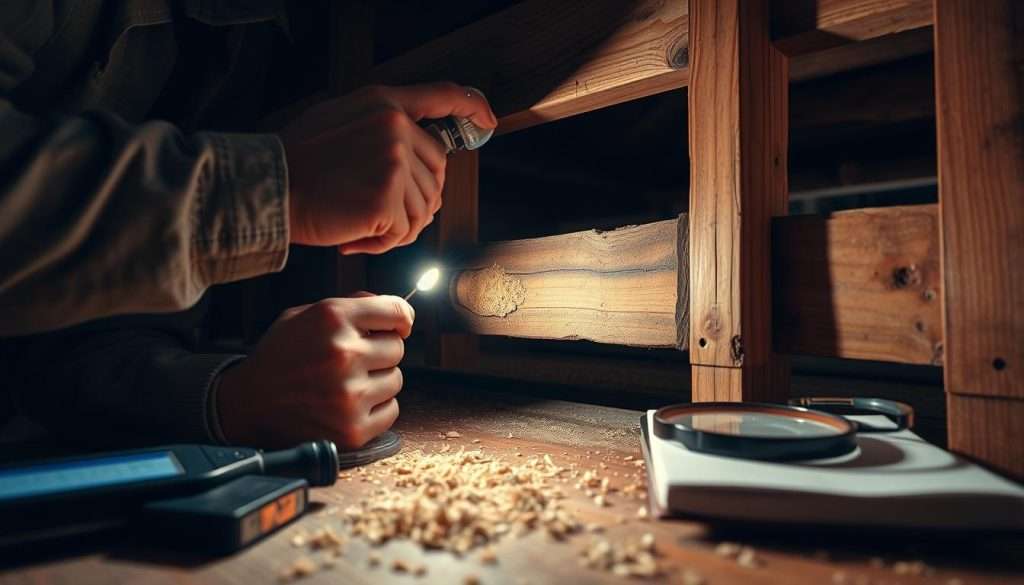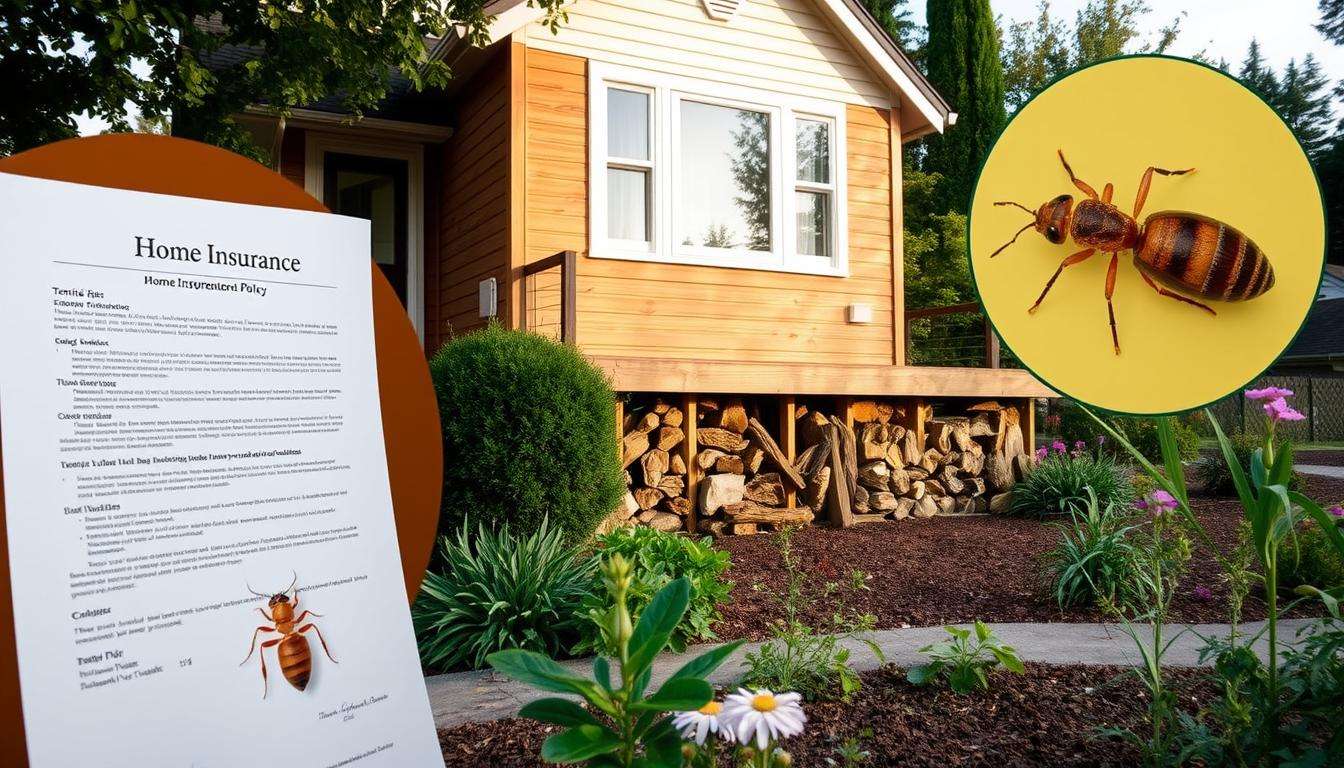It’s important to know if your homeowners insurance covers termite damage. Termites cause $5 billion in damage each year, says the National Pest Management Association. They can live in your home for years, damaging beams, walls, and furniture.
This guide will help you understand how homeowners insurance and termite damage are connected. You’ll learn what your policy covers and what it doesn’t. We’ll also talk about common termite damage and how to prevent it.
Key Takeaways
- Termites are responsible for $5 billion in property damage annually.
- Most homeowners insurance policies do not cover termite damage.
- Proactive measures and inspections can help prevent infestations.
- Signs of termite damage include wood that feels soft and mud tubes.
- Termite treatment and inspection costs range from $75 to $995.
- In rare cases, home insurance may cover termite damage caused by other covered events.
Understanding Homeowners Insurance
Homeowners insurance protects you from unexpected events. It covers damage from fire, theft, and extreme weather. But, it doesn’t cover pest damage like termites. Knowing what’s not covered is key to managing risks.
What Typically is Covered
A typical policy covers:
- Damage from fires or storms.
- Loss of personal items due to theft.
- Protection if someone gets hurt on your property.
These benefits give you peace of mind. But, not everything is covered. You must take care of your home to avoid certain exclusions.
What is Excluded from Homeowners Policies
Some things not covered include:
- Damage from termites and pests.
- Costs for pest control treatments.
- Repairs for damage from neglect or poor maintenance.
Insurance companies say these are things you can prevent. Regular checks and upkeep can help avoid termite damage and costly repairs.
Does Home Insurance Cover Termites
Many homeowners wonder if their insurance covers termites. Most policies say no. They see termite damage as something you can prevent. If you don’t stop termites, your insurance might not help.
Common Exclusions for Pest-Related Damages
Home insurance usually doesn’t cover pest damage, like termites. Here’s why:
- Termite damage is seen as a maintenance or neglect issue.
- Insurers think pest infestations happen over time, not suddenly.
- They might not pay for damaged personal items, with limits based on your policy.
Rare Exceptions Where Coverage May Apply
But, there are some cases where insurance might help:
- If termites cause your house to collapse and you didn’t know, you might get help.
- If a covered event, like fire, indirectly causes termite damage, you could file a claim.
- In some cases, you might get compensation for termite damage up to your policy limit.
This table shows when you might get help:
| Scenario | Coverage Status |
|---|---|
| Termite infestation leading to structural collapse | May be covered, depending on lack of prior knowledge |
| Fire causing termite damage | Potential for coverage if linked to a covered peril |
| Damage to personal belongings by termites | Not covered, capped payouts depending on policy |
It’s important to check your home often, especially in warm, wet places. Knowing what your insurance covers can help you avoid big costs later.

Types of Termite Damage
It’s important for homeowners to know about termite damage. These insects can harm your home’s structure and belongings. Knowing about termite damage helps you prevent and check for it.
Structural Damage and Its Implications
Structural damage from termites is very serious. They can damage important wooden parts like:
- Floor joists
- Walls
- Beams
This damage can make your home unstable. It might need expensive repairs. Sometimes, repairs include:
- Replacing damaged wood
- Strengthening weak spots
- Moving out while repairs are done
Many homeowners find that insurance doesn’t cover termite damage. Most policies see it as a maintenance issue.
Impact on Personal Property
Termites don’t just harm your home’s structure. They can also damage your belongings. Things like furniture, cabinets, and electronics can get damaged. Common problems include:
- Wood furniture getting damaged
- Cabinets with soft spots or holes
- Floors showing damage or wear
If termites damage your belongings, check your insurance policy. Coverage limits vary. Regular checks can catch problems early and save money.
| Type of Damage | Description | Potential Costs |
|---|---|---|
| Structural Damage | Damage to foundational supports, such as beams and joists. | $250 to $5,000 for repairs |
| Personal Property Damage | Destruction of furniture, electronics, and cabinetry. | Varies by item and insurance limitations |
| Detection Challenges | Termites often live undetected, causing hidden damage. | Inspection fees around $100 to $300 |
Preventing Termite Infestations
Keeping termites away is key for homeowners. A good plan can save a lot of money on termite treatment. This money is often spent because of big termite problems. By taking the right steps, you can make your home less appealing to termites.
Proactive Measures Homeowners Can Take
There are many ways to lower the risk of termites:
- Get rid of things like firewood, mulch, and wood debris near your house.
- Check your home often for cracks and seal any holes.
- Keep the area around your foundation dry to avoid moisture.
- Store firewood at least 20 feet from your house and keep it off the ground.
- Use treated wood for any building projects on your property.
- Regularly cut back plants and trees that are close to your house.
The Role of Regular Inspections
Getting your home checked by a pro is very important. Doing this once a year can find problems early. A termite check costs between $75 to $200 a year.
By following these tips and getting regular checks, you can keep termites away. Finding problems early can save your home and give you peace of mind.

What to Do If You Discover Termite Damage
Seeing termite damage in your home is scary. But, acting fast can lessen the problem. First, check the damage well. Look for hollow wood, mud tubes, and wall or floor damage.
Spotting damage early can save you money and time. It helps fix the problem quickly.
Assessing the Damage
Knowing how bad the damage is is key. If you find signs of termites, here’s what to do:
- Check hidden spots like basements and attics.
- Look for moisture, as termites love damp places.
- Take photos of the damage for insurance claims.
Choosing the Right Pest Control Service
Finding a good pest control service is important. Here’s how to pick the right one:
- Look for licensed and insured pros.
- Ask for free checks and quotes.
- Choose eco-friendly treatments.
Get quotes from different services to compare termite treatment costs. Costs can be from $250 to $5,000, based on the damage. Regular checks or yearly treatments can prevent big damage. Termites cause about $5 billion in damage yearly.
Being proactive, like regular checks, lowers infestation risks. If insurance might cover damage, document everything well. Talk clearly with your insurance company. For more on termite damage and insurance, see this link.
Conclusion
Homeowners insurance usually doesn’t cover termite damage because it’s preventable. Termite damage can cost homeowners about $3,000 to fix. This is a lot of money that can be avoided with regular checks and upkeep.
While some policies might cover termite damage in rare cases, like an accidental fire, these are not common. It’s important to know what your insurance covers to avoid surprise costs. Keeping your home maintained and watching for early signs of termites can help a lot.
Learning about home insurance and termite damage helps us protect our homes. We can avoid big repair costs by doing regular checks, keeping gutters clean, and managing our yard. These steps help keep our homes safe from termites in the future.
